2. 中国科学技术大学地震与地球内部物理实验室, 合肥 230026
2. Laboratory of Seismology and Physics of Earth's Interior, University of Science and Technology of China, Hefei 230026, China
地球内核位于地球的最中心,其半径为1221 km.内核处于极端的高温高压环境下,其压强为330~364 GPa,温度约为5000~6000 K.地球内核主要由铁以及少量的镍和轻元素构成.目前,对内核中轻元素的种类及含量尚存在很大争议,氢、碳、氧、硫、钾和硅中的一种或多种都可能存在于内核中.铁和铁合金在内核所处的极端温压条件下的稳定结构也存在争议.理论计算表明,纯铁以六方密排结构(hcp)稳定存在(Vočadlo et al., 2000),但若将可能存在的轻元素考虑进去,铁合金也能以体心立方结构(bcc)(Belonoshko et al., 2003; Vočadlo et al., 2003)或面心立方结构(fcc)(Vočadlo et al., 2008)稳定存在.而高温高压实验结果表明,纯铁(Tateno et al., 2010)、铁镍合金(Tateno et al., 2012)和铁镍硅合金(Sakai et al., 2011)在内核温压条件下均只能以六方密排结构稳定存在.尽管内核中铁合金的真实组分尚不清楚,可能的铁合金组分及其稳定结构尚需进一步的实验,但现有的证据更倾向于支持内核中铁合金以六方密排结构稳定存在.
尽管地球内核占整个地球体积的比例不到1%,但其在地球演化和地球磁场的形成中扮演着举足轻重的角色.固态内核形成于约10亿年前(Labrosse et al., 2001),随着地球的冷却由液态外核逐渐凝固而成(Jacobs, 1953).内核增长过程中会释放潜热并抛出轻物质,驱动外核对流(Braginsky, 1963; Fearn and Loper, 1981),进而构成了地磁发电机并产生了地球的磁场(Gubbins, 1977; Loper, 1978).其中,内核增长过程中释放出的潜热为外核对流提供了热能,而释放的轻元素则在地球重力场作用下由地球内核表面上浮至地球外核顶部,为外核对流提供了化学驱动力.因此,研究地球内核表面凝固过程是了解地球外核对流和地磁发电机物理机制的关键.同时,因为内核边界是外核成分的固液平衡相变面,所以内核的凝固过程记录了当时外核底部的热力学和化学状态.因而,研究地球内核内部的地震学结构对认识地球内核凝固的历史,即地球外核对流和地球演化的历史,具有决定性的作用.同样,对当今地球内核表面的研究有助于我们了解当今地球外核对流的驱动力和地磁场的成因.
传统观念认为,因为地球外核液体粘性低,外核应该快速、小尺度地对流,因而地球外核的横向温度及成分变化应该极小(Stevenson, 1987),地球内核的凝固过程应该在不同地理位置上是均匀的,内核表面应该是均匀光滑的.然而,现代地震学揭示,地球内核内部及其表面都呈现相当复杂的结构属性.这些地震学的结果对传统观念提出了挑战,同时也引发了对一系列新的物理机制的探讨.本文将介绍地球内核及其边界结构的研究进展.我们首先介绍地震学中用于研究内核结构的工具与方法,接着着重介绍近几十年来内核及其边界结构的地震学研究结果,包括内核各向异性、东西半球差异、内核边界的地形起伏以及糊状层等精细结构,并探讨这些复杂内核结构揭示的可能的物理机制.
1 地震学研究方法由于无法获取地球内核的矿物样品,地震学是唯一一个能够直接对地球内核结构进行探测的学科.穿过地球内核的地震波携带了内核结构相关的信息,可以用来约束内核内部的介质属性(密度、地震波速度、衰减以及各向异性结构)以及内核边界的精细结构(内核边界地形、尖锐度、过渡层以及糊状层等).用于研究地球内核结构的数据主要包括两类:短周期的地震体波(中心频率约为1 Hz)和长周期的地球自由振荡简正振型(频率低于10 mHz).这两类数据对内核结构有着不同的约束.体波数据的走时、振幅和波形信息,可以用来约束内核的速度、衰减结构和内核边界的精细结构,但由于地震和台站的分布不均匀,体波数据仅能采样到内核的部分区域.反之,自由振荡简正振型资料可以约束大尺度不均匀结构,且其不受限于地震和台站的分布,是对内核体波数据的重要补充,但其对于内核结构的区域性变化和精细结构不敏感.同时,简正振型中只有少部分的模态对内核结构敏感,而且即使那些对内核敏感的振荡模态也很大程度上受到地幔结构的影响,所以利用自由振荡简正振型的分裂得到的内核结构也可能因为地幔结构的不确定性而存在较大的误差.
1.1 内核体波内核研究中最常用的体波震相是以压缩波形式穿过内核的短周期PKIKP震相(图 1),有些文献中也称为PKPdf或PKP(DF).PKIKP震相的走时、振幅以及波形受到内核速度、各向异性和衰减结构的影响.例如,若穿过内核某个区域的PKIKP震相到得早且振幅比较小,则表明内核中该区域有更快的传播速度和更强的衰减.因此,分析和模拟PKIKP震相的属性是研究内核结构的主要手段.实际研究中,由于PKIKP震相在震源端和台站端两次穿过地壳和地幔(图 1a),而地壳、上地幔以及地幔底部具有强烈的横向不均匀结构,所以在利用PKIKP震相的走时和振幅来研究内核结构时需要对这些不均匀体的影响做校正(Poupinet et al., 1983; Morelli et al., 1986).目前,地震学对地幔和地壳路径中介质不均匀性的了解尚存在很大的误差.因此,利用PKIKP震相的绝对走时和绝对振幅研究内核的精度也受到了很大的限制,相关的研究结果也存在很大的误差和不确定性.地震学研究中更准确的方法是寻找一个与PKIKP射线路径相近但又不穿过内核的震相作为参考震相,利用PKIKP和参考震相之间的相对到时和振幅比来约束内核结构.由于PKIKP震相与其参考震相在地球内核之外的传播路径相近,利用PKIKP及其参考震相之间的相对信息(相对到时差、振幅比和相对波形差异)可以有效消除时钟误差、震源定位误差、震源机制误差、震源时间函数复杂性以及地球浅部结构的影响.在130°~143°震中距范围内,内核边界的反射波PKiKP可以作为PKIKP的参考震相,用于研究内核顶部100 km厚度内的结构(图 1);在146°~156°震中距范围内,在外核底部折返的PKPbc可作为参考震相,用于研究内核顶部150~350 km内的结构(图 1);对于更大震中距范围,在外核中部折返的PKPab以及在内核边界下表面反射的PKIIKP可作为参考震相,用于研究内核边界下方350~1221 km(即内核中心约900 km)的内核结构(图 1).但是,由于PKIKP与PKPab以及PKIIKP的射线路径在地幔中相差很大,利用PKPab和PKIIKP作为参考震相的相对信息仍然受到地幔和地壳不均匀结构的影响,利用这些资料得到的内核深部结构的误差和不确定性也相对较大.

|
图 1 (a) 用于内核研究的地震体波的射线路径(以震中距30°、138°、150°和180°为例);(b)地震体波震相PKP的走时曲线,包括PKIKP、PKiKP、PKPbc和PKPab Fig. 1 (a) Raypaths of seismic body waves used to study the Earth′s inner core structure at four example epicentral distances of 30°, 138°, 150° and 180°; (b) Travel time curves of seismic PKP phases, including PKIKP, PKiKP, PKPbc and PKPab |
以剪切波形式在内核传播的震相,如PKJKP(图 1a),是证明内核是固态的最直接证据,也是研究内核剪切波结构的重要资料.但由于内核边界处压缩波到剪切波的转换效率低(Bullen, 1951),且内核可能具有很强的剪切波衰减(Doornbos, 1974),因此,PKJKP很难在实际数据中直接观测到.近些年,随着台阵资料的增加和分析技术的发展,有些研究也报道了PKJKP震相的观测和研究结果(Julian et al., 1972; Okal and Cansi, 1998; Deuss et al., 2000; Cao et al., 2005; Wookey and Helffrich, 2008; Shearer et al., 2011).
从地球内核边界反射的压缩波PKiKP是用于研究内核边界精细结构的主要震相(图 1a).在0~90°震中距范围内,PKiKP震相从内核边界上前临界反射,对内核边界附近的精细结构十分敏感.因此,分析和模拟这段震中距内的PKiKP震相资料成为研究内核表面精细结构的关键.通常,在利用前临界反射的PKiKP震相研究内核表面精细结构时也需要利用核幔边界反射的PcP震相或直达P震相作为参考震相(图 1a).利用PKiKP及其参考震相之间的相对走时、振幅比和相对波形差异可以研究内核边界的深度(Engdahl et al., 1974)、椭率(Souriau and Souriau, 1989)、剪切波波速和密度跳变(Shearer and Masters, 1990; Cao and Romanowicz, 2004a; Koper and Pyle, 2004; Koper and Dombrovskaya, 2005)、地形起伏(Koper et al., 2003; Dai et al., 2012; Li et al., 2014; Tanaka and Tkalčić, 2015; Shen et al., 2016)以及糊状层结构(Tian and Wen, 2017).除此之外,PKiKP震相的尾波还用于研究内核顶部或内核边界附近的小尺度散射体(Vidale and Earle, 2000; Koper et al., 2004; Leyton and Koper, 2007)以及内核中可能存在的不连续面(Leyton et al., 2005; Kawakatsu, 2006).在后临界震中距范围内(130°~145°),PKiKP震相还被用于研究内核边界随时间的变化(Wen, 2006; Cao et al., 2007; Song and Dai, 2008; Yao et al., 2015).
1.2 自由振荡简正振型分裂大地震激发的地球自由振荡简正振型的分裂为研究地球内核结构提供了另一类补充资料.内核研究中利用的简正振型资料为球型振荡资料nSl.内核内部的不均匀结构和各向异性会使某些nSl的2l+1个振荡模态的频率产生分裂,表现为频谱上的若干个谱峰(图 2).因此,观测数据中一些简正振型的异常分裂可用于约束内核结构的各向异性及不均匀性.例如,3S2和13S2等简正振型的分裂通常用来研究内核的速度各向异性(Woodhouse et al., 1986; Tromp, 1993)和衰减各向异性(Mäkinen and Deuss, 2013a, b; Mäkinen et al., 2014),而17S4和5S10等简正振型的分裂则用来研究内核的东西半球差异(Deuss et al., 2010)等等.
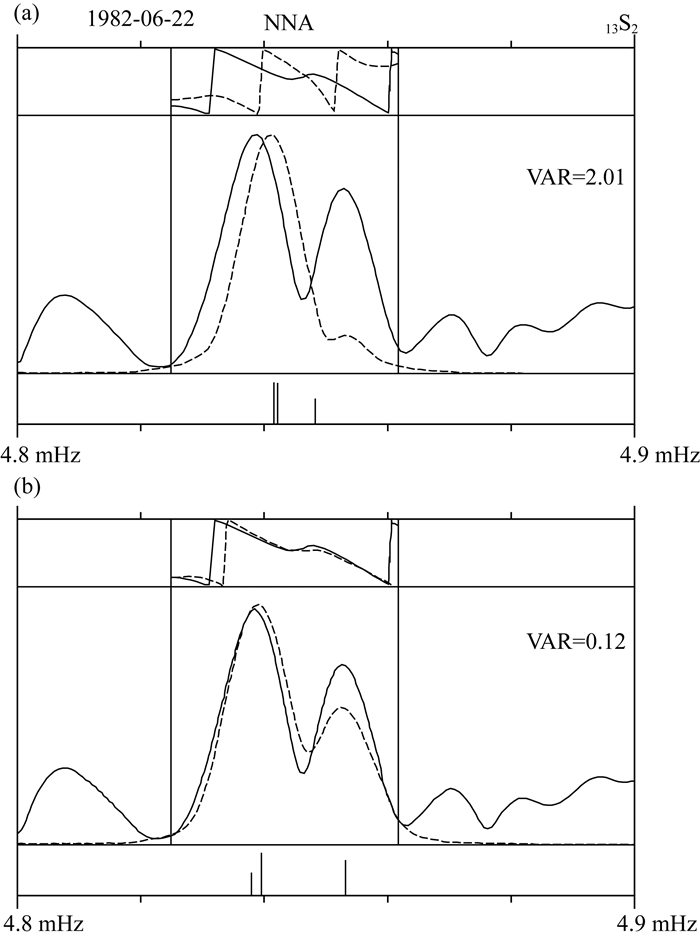
|
图 2 地球自由振荡简正振型13S2的谱分裂现象以及内核速度各向异性对其的影响 (a)观测谱(实线)与理论预测谱(虚线)的相位(上图)和振幅(中图)之间的对比.下图给出了多个子谱的频率(单位为mHz)及相对强度.计算理论预测谱时只考虑了地球的自转及椭率的影响; (b)与a相同,但在计算理论预测谱时加入了内核速度各向异性的影响.引自Woodhouse等(1986),并做了一些修改. Fig. 2 Splitting of normal mode 13S2 and effects of inner core velocity anisotropy (a) Comparisons of observed spectra (solid lines) and theoretical spectra (dashed lines) in terms of phase (top panel) and amplitude (middle panel). The bottom panel shows the frequencies in mHz and relative excitations of the singlets within the multiplet. The theoretical spectra are calculated incorporating only Earth′s rotation and ellipticity; (b) Same as a, except that the calculations of theoretical spectra also take the effects of inner core velocity anisotropy into consideration. Modified from Woodhouse et al. (1986). |
地球内核的主要特征表现为其地震波速度和衰减呈现各向异性,且各种结构(速度、衰减和各向异性)均呈现东西半球差异.
2.1 内核各向异性Poupinet等(1983)最先对全球PKIKP走时残差数据进行统计分析,他们发现位于两极区域的台站记录的PKIKP震相走时要比位于赤道区域的台站记录的PKIKP走时要小.他们认为造成这种走时差别的原因是因为地球内核半径在两极地区比赤道地区大200 km左右.1986年,Morelli等(1986)和Woodhouse等(1986)重新分析了PKIKP震相走时,同时结合观测到的对内核结构敏感的简正振型的异常分裂,第一次提出了地球内核速度呈现各向异性,来解释地震学观测资料.随后,有许多学者对地球内核各向异性结构作了深入的研究.早期研究提出的各向异性结构是轴对称模型,其柱对称各向异性轴平行于地球旋转轴,沿平行于地球旋转轴方向的地震压缩波传播比较快,而沿平行于赤道方向的地震压缩波传播比较慢(图 3).早期使用国际地震中心提供的PKIKP绝对走时数据得到的内核各向异性强度为1%~3%(Morelli et al., 1986; Shearer and Toy, 1991; Shearer, 1994; Su and Dziewonski, 1995),而后来使用PKPbc-PKIKP相对走时差得到的内核速度各向异性强度则约为3%~4%(Creager, 1992; Vinnik et al., 1994; McSweeney et al., 1997; Creager, 1999; Garcia and Souriau, 2000; Sun and Song, 2008b; Irving and Deuss, 2011).
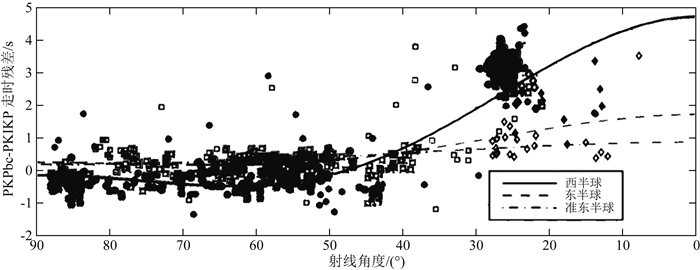
|
图 3 地球内核波速各向异性.PKPbc-PKIKP走时残差和PKIKP在内核中的射线段与地球旋转轴的夹角之间的关系 实心和空心符号分别代表采样了西半球和东半球的PKIKP数据.实线、虚线和点划线分别代表能拟合西半球、东半球和准东半球观测的均匀各向异性模型所预测的PKPbc-PKIKP走时残差与PKIKP在内核中的射线段与地球旋转轴夹角之间的关系.引自Creager(1999),并做了一些修改. Fig. 3 Inner core velocity anisotropy. PKPbc-PKIKP differential travel time residuals plotted versus the angle of the ray inside the inner core with respect to the Earth′s rotation axis Solid and open symbols represent PKIKP observations which sample the inner core in the western hemisphere and eastern hemisphere, respectively. Curves are predictions from uniform anisotropy models which fit the western hemisphere data (solid line), eastern hemisphere data (dashed line), and the quasi-eastern hemisphere data (dash-dotted line). Modified from Creager (1999). |
随着地震资料的增加和地震学研究的深入,地球内核各向异性结构的复杂性也逐渐呈现出来.在130°~143°震中距范围内记录到的PKiKP和PKIKP观测数据发现,PKiKP-PKIKP走时差基本不随着射线角度的变化而变化,表明内核顶部~100 km具有很弱的各向异性甚至是完全各向同性(Niu and Wen, 2001; Ouzounis and Creager, 2001; Garcia, 2002; Yu and Wen, 2007; Waszek and Deuss, 2011).内核各向异性也被发现呈现东西半球差异(Tanaka and Hamaguchi, 1997; Deuss et al., 2010),我们将在2.2节中详细讨论.在内核的最深处300~600 km内可能存在一个各向异性特征不同的内内核,其慢传播速度的方向与地球旋转轴之间的夹角可能在45°左右(Ishii and Dziewoński, 2002, 2003; Cao and Romanowicz, 2007; Niu and Chen, 2008; Sun and Song, 2008a),或其快传播方向近平行于赤道(Beghein and Trampert, 2003; Wang et al., 2015; Wang and Song, 2017).但内内核是否存在依然有较大争议.有研究认为用于推断内内核存在的地震学观测结果是由于地震波穿过速度存在差异的东西半球所产生,并非因为内核中心具有不同的各向异性属性(Lythgoe et al., 2014),也有研究资料表明内核中心的各向异性快轴方向平行于地球自转轴,和内核其它区域并无不同(Calvet et al., 2006; Romanowicz et al., 2016).
地震学研究也很早认识到地球内核介质的衰减结构可能呈现各向异性.Souriau和Romanowicz(1996, 1997)从PKIKP/PKPbc和PKIKP/PKPab的振幅比中观测到沿着极向传播的PKIKP比沿着赤道方向传播的PKIKP具有更小的振幅.她们解释那些观测结果为内核衰减结构和地震波速类似,呈现各向异性.Yu和Wen(2006a)进一步分析了穿过内核不同区域和不同方向的PKIKP资料,发现地震波速和地震衰减具有极好的相关性:沿旋转轴方向传播速度快(3%~4%)且衰减大(Q=200~250),而沿赤道方向传播速度慢且衰减小(Q=300~600).他们指出这些观测结果不但表明内核介质衰减呈现各向异性,而且可能要求内核晶体同时具有速度和衰减各向异性,并且高速轴方向对应于高衰减轴方向.他们指出具有这种属性的内核晶体定向排列可形成目前观测到的内核高速和高衰减的普遍相关性.随后,简正振型的观测也支持内核衰减存在各向异性的结论(Mäkinen and Deuss, 2013a, b; Mäkinen et al., 2014).
总结目前地球内核各向异性的研究结果:地震学观测表明地球内核的压缩波速度和衰减呈现出柱对称各向异性,各向异性对称轴平行于地球旋转轴,沿旋转轴方向传播速度快(3%~4%)、衰减大(Q=200~250),而沿赤道方向传播速度慢、衰减小(Q=300~600).内核的各向异性结构在深度上也存在变化:内核顶部存在一个约100 km厚的各向同性层,内核深部各向异性强度呈现东西半球差异,内核中心可能存在一个半径约为300~600 km的各向异性特征不同的内内核.
2.2 内核东西半球差异Niu和Wen(2001)发现PKiKP-PKIKP走时残差存在明显的东西半球差异,穿过内核东半球的PKIKP震相走时比穿过内核西半球的PKIKP震相走时早约0.8 s,表明东半球内核顶部~100 km厚度内各向同性速度比西半球快约0.8%(图 4).Wen和Niu(2002)进一步揭示地震波衰减也呈现东西半球差异,西半球具有较弱的衰减(Q=600),而东半球则具有较强的衰减(Q=250).内核顶部各向同性层的厚度也存在东西半球的差异,西半球各向同性层厚度约为100 km,而东半球各向同性层厚度约为400 km(Garcia and Souriau, 2000; Niu and Wen, 2002).随后,更多研究进一步证实了内核顶部各向同性速度(Garcia, 2002; Monnereau et al., 2010; Irving and Deuss, 2011; Waszek and Deuss, 2011; Tanaka, 2012)和衰减结构(Cao and Romanowicz, 2004b; Yu and Wen, 2006a, b; Cormier, 2007; Yu and Wen, 2007; Waszek and Deuss, 2013)存在东西半球差异.
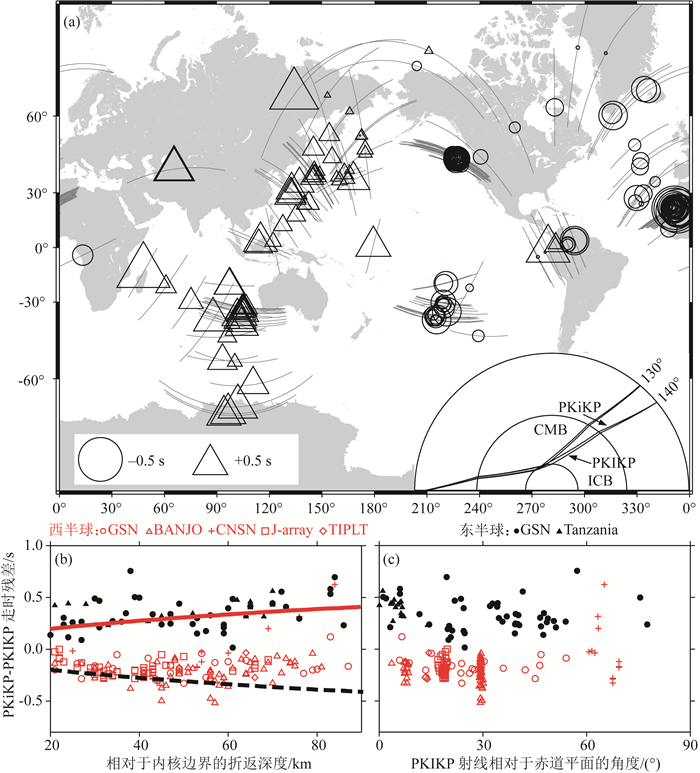
|
图 4 地球内核顶部速度结构的东西半球变化 (a) PKiKP-PKIKP走时残差的地理分布图.PKIKP在内核中穿过的射线段及折返点的位置分别用线条和符号表示.圆和三角符号分别表示负和正的走时残差,符号的大小与走时残差的绝对值成正比; (b) PKiKP-PKIKP走时残差与PKIKP在内核中的折返深度之间的关系.实心和空心符号分别代表东半球和西半球的PKIKP数据.实线和虚线分别对应内核顶部100 km比PREM模型快0.5%和慢0.5%的模型所预测的PKiKP-PKIKP走时残差与PKIKP折返深度之间的关系; (c) PKiKP-PKIKP走时残差和PKIKP在内核中的射线段与地球赤道平面间夹角的关系.实心和空心符号分别代表采样了东半球和西半球的PKIKP数据.引自Niu and Wen(2001),并做了一些修改. Fig. 4 Hemispherical variations in seismic velocity at the topmost inner core (a) Map view of PKiKP-PKIKP travel time residuals, plotted as lines along ray segments through the inner core and symbols at the turning points. Positive and negative residuals are represented by triangles and circles, with the size of the symbols proportional to the absolute value of residuals; (b) PKiKP-PKIKP travel time residuals as a function of PKIKP turning depth below the inner core boundary. Solid and open symbols represent the eastern and western hemispheres, respectively. The solid and dashed lines denote the predicted PKiKP-PKIKP travel time residuals for two models with a topmost 100-km layer 0.5% faster and 0.5% slower than PREM in the inner core. (c) PKiKP-PKIKP travel time residuals as a function of PKIKP ray angle from the equatorial plane. Solid and open symbols represent the eastern and western hemispheres, respectively. Modified from Niu and Wen (2001). |
内核速度各向异性也存在东西半球的差异.赤道向的PKPbc-PKIKP和PKPab-PKIKP走时残差没有表现出明显的东西半球变化,表明内核深部东西半球的各向同性速度差异小于0.5%(Irving and Deuss, 2011; Tanaka, 2012).穿过内核西半球的极向路径的压缩波表现出明显的走时异常,意味着在西半球存在较强的内核速度各向异性(各向异性强度最高为5%);而穿过东半球的极向路径的压缩波则没有表现出明显走时异常,表明内核东半球的速度各向异性很弱(各向异性强度小于0.7%)(Tanaka and Hamaguchi, 1997; Creager, 1999; Niu and Wen, 2002; Irving and Deuss, 2011),甚至是完全各向同性(Lythgoe et al., 2014).简正振型观测也进一步证实了内核速度各向异性的东西半球差异(Deuss et al., 2010).
总结目前地球内核内部结构的研究结果,内核内部结构横向不均匀性的最显著的特征是内核结构呈现东西半球差异:内核西半球各向同性层厚度约为100 km,具有较慢的各向同性速度和较弱的衰减(Q=600),而内核东半球各向同性层厚度则约为400 km,具有较快的各向同性速度和较强的衰减(Q=250).东西半球的各向同性速度差异为0.8%.在各向同性层底下,西半球具有较强的速度各向异性(~4%),东半球具有较弱的速度各向异性(~0.7%).
3 地球内核边界精细结构与传统观点相悖,现代地震学发现地球内核表面局部存在地形起伏和糊状层.
3.1 内核边界地形起伏虽然传统观点一直认为地球内核边界应该是光滑的、不具有地形起伏,但是对重复地震所激发的PKiKP震相的研究发现内核边界在10年左右的时间尺度内在局部地区变化了1~6 km,首次暗示着内核边界可能存在着公里量级的地形起伏(Wen, 2006; Cao et al., 2007; Song and Dai, 2008; Yao et al., 2015).内核边界局部地区存在小尺度地形起伏的更直接证据来自前临界反射的PKiKP震相.Dai等(2012)通过分析PKiKP-PcP走时差和PKiKP/PcP振幅比,发现菲律宾海下方的内核边界存在14 km的地形起伏(图 5).随后,更多的地震观测在内核其它局部区域发现地形起伏,如中美洲下方的内核边界可能存在10 km的地形突变(Li et al., 2014),西太平洋下方的内核边界存在波长和高度均为1~1.5 km的正弦状或尖刺状地形起伏(Tanaka and Tkalčić, 2015)以及黄海下方的内核边界存在一个宽度为100 km、高度为2~3 km的地形凹陷(Shen et al., 2016)等.
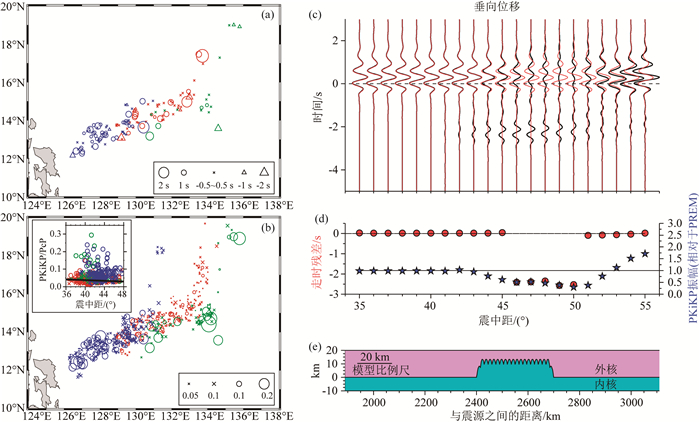
|
图 5 地球内核边界地形起伏 (a) PKiKP-PcP走时残差的地理分布.图中圆和三角分别代表正和负的走时残差,符号的大小与走时残差的绝对值成正比; (b) PKiKP/PcP振幅比的地理分布.其中圆圈代表可靠的PKiKP和PcP观测的振幅比,叉号代表PcP震相可清楚观测而PKiKP不可见的数据的振幅比信息,其可以作为振幅比的下限.左上角小图中展示了振幅比随震中距的变化关系,其中黑线是PREM模型的理论预测振幅比; (c)内核边界起伏地形模型(黑色波形)和PREM模型(红色波形)计算得到的PKiKP理论地震图; (d)内核边界地形起伏模型相对于PREM模型的PKiKP走时残差(红点,左坐标轴)和振幅(蓝色五角星,右坐标轴)与震中距的关系; (e)大尺度和小尺度地形叠加的内核边界地形起伏模型.引自Dai et al.(2012),并做了一些修改. Fig. 5 Topographic variations of the inner core boundary (ICB) (a) Map view of PKiKP-PcP travel time residuals, plotted at the PKiKP bouncing points at the ICB. Positive and negative residuals are represented by circles and triangles, with the size of symbols proportional to the absolute value of residuals; (b) Map view of PKiKP/PcP amplitude ratios, plotted at PKiKP bouncing points at the ICB. Circles denote the amplitude ratios of observations with reliable PKiKP and PcP, and crosses denote the amplitude ratios of observations with invisible PKiKP and clear PcP, which should be considered as a lower bound of the amplitude ratios. The amplitude ratios are also plotted in the inset as a function of epicentral distance, along with predictions based on PREM (thick line); (c) Synthetic PKiKP seismograms for PREM (red traces) and a topographic ICB model shown in e (black traces); (d) PKiKP travel time residuals (red dots, left scale) and amplitudes (blue stars, right scale) with respect to PREM predictions for a topographic ICB model shown in e; (e) A ICB model with a superposition of large-scale and small-scale topography, plotted as a function of distances from the seismic source. Modified from Dai et al. (2012). |
根据冶金学的经验和理论分析,Fearn和Loper(1981)提出在内核增长过程中液态外核会以树突状结构在内核表面凝结,形成固液共存的糊状层,即地球内核边界附近可能包含三个区域:以纯液态形式存在的上部区域(即地球外核),以纯固态形式存在的下部区域(即地球内核)和以固液态共存形式存在的中间区域(即糊状层).糊状层的地震学属性及厚度由外核组分和铁与轻元素的共晶组分之间的差异决定.但是,糊状层的存在一直没有地震学证据的支持,直至Tian和Wen(2017)通过研究PKiKP与PcP震相之间的波形差异,发现鄂霍次克海西南部下方的局部内核边界存在4~8 km厚的糊状层.研究还发现东亚下方其它区域的内核边界呈现出一个尖锐的界面(图 6).这一研究首次提供了内核表面存在糊状层的地震学证据并约束了糊状层的厚度,同时也表明糊状层仅存在于内核边界处局部区域.
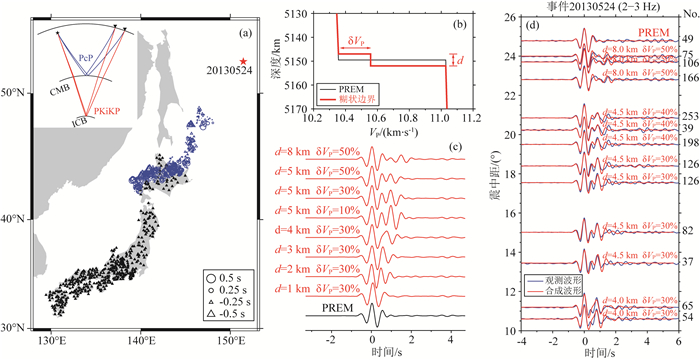
|
图 6 鄂霍次克海西南部下方的局部糊状内核边界 (a)局部糊状内核边界的地理位置(蓝色符号).由地震事件(红色五角星)激发并被日本Hi-net台网(黑色三角形)记录的PKiKP震相采样了这一区域.PKiKP-PcP走时残差用蓝色符号表示,圆和三角分别代表正和负残差,符号的大小与走时残差的绝对值成正比; (b)糊状内核边界模型(红线),简化为由两个参数决定:糊状层厚度d和P波速度跳变相对于PREM速度跳变的百分比δVP,黑线代表PREM模型中的内核边界; (c)不同厚度d和P波速度跳变δVP糊状内核边界模型(红色波形)和PREM模型(黑色波形)计算得到的PKiKP理论波形; (d) PKiKP观测波形(蓝色波形)与最佳拟合糊状内核边界模型预测的理论波形(红色波形)的对比.最佳拟合模型的厚度与速度跳变标记在波形右上方.引自Tian and Wen(2017),并做了一些修改. Fig. 6 Localized mushy zone at the Earth′s inner core boundary beneath southwest Okhotsk Sea (a) Geographic location of localized mushy ICB (blue symbols). PKiKP waves excited by a seismic source (red star) and recorded by the Hi-net stations (black triangles) sample this localized region. PKiKP-PcP travel time residuals are plotted at the PKiKP bouncing points at the ICB (blue symbols). Positive and negative PKiKP-PcP travel time residuals are denoted by circles and triangles, respectively, with the size of symbols proportional to the absolute value of residuals; (b) Mushy ICB model (red line) represented by two parameters: d, the thickness of the layer, and δVP, percentage compressional velocity jump of the top layer with respect to PREM velocity jump at the ICB, along with PREM (black line); (c) Synthetic seismograms for a series of mushy ICB models (red traces, labeled accordingly with two model parameters: d and δVP) and for PREM (bottom black trace); (d) Comparisons of observed PKiKP waveforms (blue traces), which sample the mushy ICB region beneath southwest Okhotsk Sea and synthetic seismograms (red traces) of the best-fitting mushy ICB models. The thickness d and percentage compressional velocity jump of the top layer δVP of the best-fitting mushy models are labeled above the red traces. Modified from Tian and Wen (2017). |
目前,内核研究中提出的各向异性的产生机制可以分为两类:晶格定向排列和形状定向排列.晶格定向排列机制认为地球内核晶体本身具有各向异性属性,而一些物理过程使内核的各向异性晶体有秩序地排列从而形成了内核各向异性;形状定向排列机制认为内核内部存在非球状液体颗粒,而且这些非球状液体颗粒沿着赤道方向定向排列,形成了地球内核各向异性(Singh et al., 2000).
早期理论计算表明,六方密排结构的铁晶体存在约4%的压缩波速度各向异性(Stixrude and Cohen, 1995),这与地震学观测到的内核各向异性的量级相当.因而Stixrude and Cohen(1995)提出地球内核各向异性是由内核铁晶体的晶格定向排列引起,内核铁晶体的晶格定向排列也要求近似完美.然而,促使内核晶体定向排列的物理机制仍然存在着争议,不同研究者提出了多种可能的内核晶体定向排列的物理机制.定向排列可能发生在内核凝固的过程中,也可能是在内核形成后发生变形导致.内核凝固过程中定向排列可能有如下几种机制:(1)在内核凝固过程中,具有磁属性的铁在磁场力的作用下产生定向排列(Karato, 1993);(2)内核在凝固过程中形成树突状结构,外核物质流从赤道处吸收更多热量,导致树突状结构沿着赤道平面定向排列,进而导致内核晶体快轴与地球旋转轴平行(Bergman, 1997).内核晶体的定向排列也可能是在内核凝固后由于受力变形而引起的,其可能的变形机制包括:(1)内核中存在大尺度热对流(Jeanloz and Wenk, 1988; Romanowicz et al., 1996);(2)地球磁场在内核边界附近产生的Maxwell应力存在纬向变化,进而驱动内核中的对称流动(Karato, 1999; Buffett and Wenk, 2001);(3)地球旋转影响外核的对流,使得赤道区域内核生长更快,内核物质为保持内核边界处于静水压平衡态从赤道流向两极,促使内核晶体沿地球旋转轴排列(Yoshida et al., 1996).
4.2 东西半球差异物理机制不同学者提出了两类物理机制来解释内核结构的东西半球差异:(1)内核由西往东横向移动导致内核东半球熔化、西半球凝固(图 7a);(2)核幔边界处的不均匀热流通过外核对流耦合到外核底部,导致东西半球不同的内核边界凝固过程(图 7b).

|
图 7 地球内核东西半球差异的两类物理机制示意图 (a)内核东西横向移动模型.在超绝热状态下,任意一阶热不均匀性会使内核的质心向相对冷和高密度的半球(左侧)移动.通过内核横向移动(自西向东,从虚线向实线位置)可以使地球的质心(o)回到平衡位置,但会产生与外核温压条件不平衡的地形h.相对高密度的西半球的结晶以及东半球的熔融可以消除地形,但同时会放大密度不均匀性而保持质心向结晶一侧移动,因此会导致内核物质在内核边界里永久性的平移,其平移速度V受相变动力学控制.最终结果是内核物质的年龄(颜色)从一边(蓝色)向另一边(黄色)增加,同时颗粒的大小也随之增加;(b)核幔边界热流引导内核不同凝固过程模型.地幔底部存在热流不均匀性,冷的核幔边界(红色区域)从外核吸收了更多的热量,而热的核幔边界(蓝色区域)则从外核吸收少量能量,继而影响了外核对流(红色和蓝色箭头分别代表上升流和下降流),造成内核边界不同区域出现横向变化的热流和凝固过程.引自Monnereau et al.(2010)和Aubert et al.(2008),并做了一些修改. Fig. 7 Illustrations of two physical mechanisms for hemispheric differences in the inner core (a) Inner core east-west translation model. In superadiabatic regime, any thermal heterogeneity of harmonic degree-one shifts the center of mass of the inner core toward its colder and denser hemisphere (left). The equilibrium position at the center of mass of Earth (o) is restored by translation of the inner core (from dashed to solid positions). This induces a topography h that is not in equilibrium with the pressure and temperature conditions within the outer core. Crystallization on the denser west hemisphere (left side) and melting on the east hemisphere (right side) act to remove the topography, but in return amplify the density heterogeneity and maintain the center of mass shifted toward the crystallizing side. It results in a permanent translation of the inner core material inside its boundary, whose velocity V is controlled by the phase-change kinetics. The main consequences are an increase of the age (in color) from one side (blue) to the opposite (yellow) and the subsequent grain-sizes; (b) Thermochemical coupling model between core-mantle boundary and inner core freezing. The lowermost mantle thermal heterogeneity extracts more heat in coder regions (red) and less heat in hotter regions (blue), and affect the liquid flow in outer core, resulting in laterally varying heat flux and solidification process at the inner core boundary. Upwellings and downwellings flow in outer core are shown with red and blue arrows, respectively. Modified from Monnereau et al. (2010) and Aubert et al. (2008). |
内核横向移动模型假定内核存在一个自西向东的微小移动.这一微小移动使得内核西半球存在一个负的地形,部分外核物质流入固液相变界面并结晶,使得内核西半球呈现出新生的小颗粒的结晶;同理,内核的东半球边界存在一个正的地形,部分内核物质移出固液相变界面并熔化,从而暴露出老的大颗粒结晶.同时,由于东西半球不同的结晶和熔融过程而产生的地球外核底部密度差异可保持地球内核继续向结晶一侧平移.内核平移最终导致内核东西半球存在不同的晶体尺寸,以此解释东西半球之间的各向同性速度和衰减的差异(图 7a)(Alboussière et al., 2010; Monnereau et al., 2010).
核幔边界热流引导模型假定核幔边界的热流不均匀,那些不均匀的热流控制液态外核的对流,导致亚洲下方的外核出现一个大型气旋直至外核底部,使得内核边界的东半球有更快的凝固速度,进而导致内核边界东半球有更随机排列的树突结构、更弱的各向异性、更快的地震波速度以及更强的衰减(图 7b)(Sumita and Olson, 1999; Aubert et al., 2008).或者,如Gubbins等(2011)基于对地磁发电机的模拟,提出地幔热流的变化可能会导致内核边界出现局部的凝固和熔化,进而产生东西半球的差异.
4.3 内核表面地形物理机制内核边界的局部小尺度地形起伏暗示着内核边界的两种可能的热动力学状态:(1)如果内核表面一直处于固液平衡态的相变面,那么内核边界地形的存在表明外核底部存在小尺度的温度或组分变化,这些小尺度的温度或组分变化使得固液相变面起伏,内核表面形成地形;(2)内核边界局部存在小尺度动力,使得内核边界产生变形,部分区域偏离固液平衡态的相变面,形成不规则地形.在这种机制下,动态变形所需的时间应小于内核边界重新熔化或凝固所需的时间,此时内核边界处于亚稳态(Dai et al., 2012; Yao et al., 2015).
4.4 内核表面糊状层对地球外核热化学状态的揭示意义内核表面糊状层的上边界受控于外核组分的凝固条件,而糊状层的下边界则由整个内外核凝固系统的共晶状态决定.因而,内核表面糊状层的厚度取决于外核组分与共晶组分之间的差异.地震学观测数据发现,仅局部区域的内核表面存在4~8 km厚的糊状层,而大部分区域的内核表面则呈现出一个尖锐的界面.这意味着,大部分区域的外核组分接近于整个凝固系统的共晶组分,从而产生了尖锐的内核边界;而在局部区域,外核组分偏离了共晶组分,产生了一个厚度为4~8 km的糊状层.内核表面局部地区糊状层的存在为我们提供了外核底部组分和内核的凝固过程存在着横向变化的另一证据(Tian and Wen, 2017).
4.5 内核结构对地球磁场驱动力的揭示意义现代地震学结果表明内核凝固过程和地球磁场的热和化学驱动力远比传统观念认为的横向均匀分布复杂得多.如果内核东西平移模型正确,那么内核属性的东西半球差异表明东西半球凝固状态存在差异,内核西半球不断凝固并释放潜热和轻元素,而东半球则不断熔化并吸收潜热和轻元素,这意味着外核对流的驱动力在东西半球呈现截然不同的相反方向.另一方面,内核表面局部区域糊状层的存在意味着内核的凝固过程在大部分无糊状地区仅释放潜热,而在局部糊状层区域则释放潜热和化学能,表明内核边界热化学驱动力在小尺度内有着横向变化.而内核表面局部地形的存在则表明内核边界存在小尺度的凝固与熔化交替过程,进一步揭示了内核边界热化学驱动力的不均匀性.这些结果将为新一代的地球磁场发动机模拟提供约束和指导,使我们在了解外核热化学对流和地磁场起因上更靠近一步.
5 总结现代地震学在研究地球内核方面取得了许多新结果.我们从一个均匀的固体内核的认识,发现了地球内核速度各向异性、衰减各向异性、随深度和地理位置而变化的复杂各向异性结构,以及标志性的东西半球差异.我们从一个均匀光滑的内核表面的认识,发现了内核表面起伏的地形和固液共存的糊状层.这些新的发现引发了对许多可能的新物理机制的探讨,也促使我们重新评估我们对外核成分、外核热化学对流、内核凝固过程和地球磁场驱动力的认识.现代地震学结果表明内核凝固过程和地球磁场的热和化学驱动力远比传统观念认为的横向均匀分布复杂得多.内核西半球可能不断凝固并释放潜热和轻元素,而东半球则可能不断熔化并吸收潜热和轻元素,外核对流的驱动力在东西半球可能截然不同,甚至呈现相反方向.这些凝固与熔化交替过程也发生在局部地形起伏区域.在糊状层区域,地球内核凝固释放潜热和化学能,而在大部分无糊状地区,内核凝固只释放潜热.
现代地震学展现的内核结构主要包括(图 8):
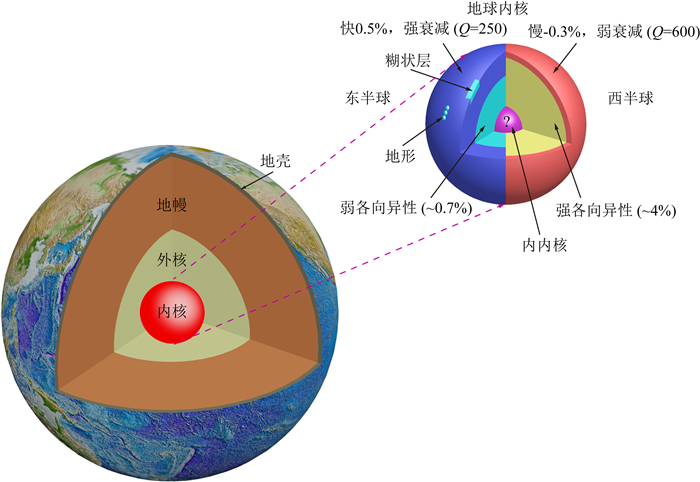
|
图 8 地球内核及其边界结构特征示意图 内核结构呈现东西半球差异:西半球顶部(各向同性层,约100 km)具有较慢的速度(相对PREM慢-0.3%)和较弱的衰减(Q=600),而东半球顶部(约400 km)具有较快的速度(相对PREM快0.5%)和较强的衰减(Q=250).在各向同性层底下,西半球具有较强的速度各向异性(~4%),东半球具有较弱的速度各向异性(~0.7%).内核最深处300~600 km内可能存在一个各向异性特征不同的内内核.在地球内核边界,局部区域存在地形起伏和糊状层. Fig. 8 Illustration of structural characteristics of the inner core and its boundary The inner core structure exhibits hemispherical differences. The topmost inner core of the western hemisphere (an isotropic layer of about 100 km) exhibits a lower velocity (-0.3% slower than PREM) and weaker attenuation (Q=600), while that of the eastern hemisphere (about 400 km thick) has a higher velocity (0.5% faster than PREM) and higher attenuation (Q=250). At depth, the strengths of inner core velocity anisotropy of the western and eastern hemispheres are ~4% and ~0.7%, respectively. There may exist an innermost inner core with a radius of 300~600 km with a distinct anisotropy. At the boundary, the inner core possesses topographic variation and mushy zone in some localized regions. |
(1) 内核的压缩波速度和衰减呈现出柱对称各向异性,各向异性对称轴平行于地球旋转轴,沿旋转轴方向传播速度快(3%~4%)、衰减大(Q=200~250),而沿赤道方向传播速度慢、衰减小(Q=300~600).内核各向异性结构随深度而变化:内核顶部约100~400 km接近各向同性,内核最深处300~600 km内可能存在一个各向异性特征不同的内内核,其慢传播方向与地球旋转轴之间的夹角可能在45°左右或其快传播方向近平行于赤道;
(2) 内核结构存在东西半球差异:在内核顶部~100 km厚度内,东半球的各向同性速度比西半球快约0.8%,东半球则具有较强的衰减(Q=250),而西半球则具有较弱的衰减(Q=600);西半球的顶部各向同性层厚度约为100 km,而东半球顶部各向同性层厚度则约为400 km;在各向同性层底下,西半球具有较强的各向异性(~4%),而东半球则具有较弱的各向异性(~0.7%);
(3) 内核边界局部存在复杂的精细结构:菲律宾海、黄海、西太平洋以及中美洲下方的内核边界存在1~14 km高的地形起伏,鄂霍次克海西南部下方的局部内核边界存在4~8 km厚的糊状层.
目前提出的形成内核各向异性的物理机制包括:
(1) 内核凝固过程中具有磁属性的铁受到磁场力的作用而定向排列,或内核在凝固过程中形成的树突状结构由于外核物质流从赤道处吸收更多热量而沿着赤道平面定向排列,导致内核的各向异性;
(2) 内核存在大尺度热对流,或内核在赤道区域优势生长使得内核物质从赤道流向两极,导致内核晶体的定向排列,形成了内核各向异性.
目前提出的形成内核东西半球差异的物理机制包括:
(1) 内核存在自西向东的横向移动,使得内核边界的温度偏离外核物质的凝固点,导致内核西半球不断结晶、东半球不断熔化,引起东西半球速度和衰减的差异;
(2) 核幔边界的不均匀热流控制液态外核的对流,使得内核边界不同区域有不同的凝固速度,或出现局部的凝固和熔化,导致产生东西半球的差异.
目前提出的形成内核表面地形和糊状层的物理机制包括:
(1) 内核表面处于固液平衡态的相变面,外核底部存在小尺度的温度或组分变化使得固液相变面起伏,形成起伏的内核表面地形;
(2) 内核边界局部存在小尺度动力,使得内核边界产生变形,使其偏离固液平衡态的相变面,形成起伏的内核表面地形;
(3) 外核底部组分存在横向变化,局部区域外核组分偏离共晶组分,在局部区域形成糊状层.
致谢谨此祝贺姚振兴先生从事地球物理教学科研工作60周年.
Alboussière T, Deguen R, Melzani M.
2010. Melting-induced stratification above the Earth's inner core due to convective translation. Nature, 466(7307): 744-747.
DOI:10.1038/nature09257 |
|
Aubert J, Amit H, Hulot G, et al.
2008. Thermochemical flows couple the Earth's inner core growth to mantle heterogeneity. Nature, 454(7205): 758-761.
DOI:10.1038/nature07109 |
|
Beghein C, Trampert J.
2003. Robust normal mode constraints on inner-core anisotropy from model space search. Science, 299(5606): 552-555.
DOI:10.1126/science.1078159 |
|
Belonoshko A B, Ahuja R, Johansson B.
2003. Stability of the body-centred-cubic phase of iron in the Earth's inner core. Nature, 424(6952): 1032-1034.
DOI:10.1038/nature01954 |
|
Bergman M I.
1997. Measurements of electric anisotropy due to solidification texturing and the implications for the Earth's inner core. Nature, 389(6646): 60-63.
DOI:10.1038/37962 |
|
Braginsky S I.
1963. Structure of the F layer and reasons for convection in the Earth's core. Soviet Phys. Dokl., 149: 8-10.
|
|
Buffett B A, Wenk H R.
2001. Texturing of the Earth's inner core by Maxwell stresses. Nature, 413(6851): 60-63.
DOI:10.1038/35092543 |
|
Bullen K è.
1951. Theoretical amplitudes of the seismic phase PKJKP. Geophysical Journal International, 6(S3): 163-167.
DOI:10.1111/j.1365-246X.1951.tb06275.x |
|
Calvet M, Chevrot S, Souriau A.
2006. P-wave propagation in transversely isotropic media:Ⅱ. Application to inner core anisotropy:Effects of data averaging, parametrization and a priori information. Physics of the Earth and Planetary Interiors, 156(1-2): 21-40.
DOI:10.1016/j.pepi.2006.01.008 |
|
Cao A M, Masson Y, Romanowicz B.
2007. Short wavelength topography on the inner-core boundary. Proceedings of the National Academy of Sciences of the United States of America, 104(1): 31-35.
DOI:10.1073/pnas.0609810104 |
|
Cao A M, Romanowicz B.
2007. Test of the innermost inner core models using broadband PKIKP travel time residuals. Geophysical Research Letters, 34(8): L08303.
DOI:10.1029/2007GL029384 |
|
Cao A M, Romanowicz B.
2004a. Constraints on density and shear velocity contrasts at the inner core boundary. Geophysical Journal International, 157(3): 1146-1151.
DOI:10.1111/j.1365-246X.2004.02330.x |
|
Cao A M, Romanowicz B.
2004b. Hemispherical transition of seismic attenuation at the top of the Earth's inner core. Earth and Planetary Science Letters, 228(3-4): 243-253.
DOI:10.1016/j.epsl.2004.09.032 |
|
Cao A M, Romanowicz B, Takeuchi N.
2005. An observation of PKJKP:inferences on inner core shear properties. Science, 308(5727): 1453-1455.
DOI:10.1126/science.1109134 |
|
Cormier V F.
2007. Texture of the uppermost inner core from forward-and back-scattered seismic waves. Earth and Planetary Science Letters, 258(3-4): 442-453.
DOI:10.1016/j.epsl.2007.04.003 |
|
Creager K C.
1992. Anisotropy of the inner core from differential travel times of the phases PKP and PKIKP. Nature, 356(6367): 309-314.
DOI:10.1038/356309a0 |
|
Creager K C.
1999. Large-scale variations in inner core anisotropy. Journal of Geophysical Research:Solid Earth, 104(B10): 23127-23139.
DOI:10.1029/1999JB900162 |
|
Dai Z Y, Wang W, Wen L X.
2012. Irregular topography at the Earth's inner core boundary. Proceedings of the National Academy of Sciences of the United States of America, 109(20): 7654-7658.
DOI:10.1073/pnas.1116342109 |
|
Deuss A, Woodhouse J H, Paulssen H, et al.
2000. The observation of inner core shear waves. Geophysical Journal International, 142(1): 67-73.
DOI:10.1046/j.1365-246x.2000.00147.x |
|
Deuss A, Irving J C E, Woodhouse J H.
2010. Regional variation of inner core anisotropy from seismic normal mode observations. Science, 328(5981): 1018-1020.
DOI:10.1126/science.1188596 |
|
Doornbos D J.
1974. The anelasticity of the inner core. Geophysical Journal International, 38(2): 397-415.
DOI:10.1111/j.1365-246X.1974.tb04131.x |
|
Engdahl E R, Flinn E A, Massé R P.
1974. Differential PKiKP travel times and the radius of the inner core. Geophysical Journal International, 39(3): 457-463.
DOI:10.1111/j.1365-246X.1974.tb05467.x |
|
Fearn D R, Loper D E.
1981. Compositional convection and stratification of Earth's core. Nature, 289(5796): 393-394.
DOI:10.1038/289393a0 |
|
Garcia R, Souriau A.
2000. Inner core anisotropy and heterogeneity level. Geophysical Research Letters, 27(19): 3121-3124.
DOI:10.1029/2000GL008520 |
|
Garcia R.
2002. Constraints on upper inner-core structure from waveform inversion of core phases. Geophysical Journal International, 150(3): 651-664.
DOI:10.1046/j.1365-246X.2002.01717.x |
|
Gubbins D.
1977. Energetics of the Earth's core. Journal of Geophysics, 43(1-2): 453-464.
|
|
Gubbins D, Sreenivasan B, Mound J, et al.
2011. Melting of the Earth's inner core. Nature, 473(7347): 361-363.
DOI:10.1038/nature10068 |
|
Irving J C E, Deuss A.
2011. Hemispherical structure in inner core velocity anisotropy. Journal of Geophysical Research:Solid Earth, 116(B4): B04307.
DOI:10.1029/2010JB007942 |
|
Ishii M, Dziewoński A M.
2002. The innermost inner core of the earth:Evidence for a change in anisotropic behavior at the radius of about 300 km. Proceedings of the National Academy of Sciences of the United States of America, 99(22): 14026-14030.
DOI:10.1073/pnas.172508499 |
|
Ishii M, Dziewoński A M.
2003. Distinct seismic anisotropy at the centre of the Earth. Physics of the Earth and Planetary Interiors, 140(1-3): 203-217.
DOI:10.1016/j.pepi.2003.07.015 |
|
Jacobs J A.
1953. The Earth's inner core. Nature, 172(4372): 297-298.
DOI:10.1038/172297a0 |
|
Jeanloz R, Wenk H R.
1988. Convection and anisotropy of the inner core. Geophysical Research Letters, 15(1): 72-75.
DOI:10.1029/GL015i001p00072 |
|
Julian B R, Davies D, Sheppard R M.
1972. PKJKP. Nature, 235(5337): 317-318.
DOI:10.1038/235317a0 |
|
Karato S I.
1993. Inner core anisotropy due to the magnetic field-induced preferred orientation of iron. Science, 262(1993): 1708-1711.
DOI:10.1126/science.262.5140.1708 |
|
Karato S I.
1999. Seismic anisotropy of the Earth's inner core resulting from flow induced by Maxwell stresses. Nature, 402(6764): 871-873.
DOI:10.1038/47235 |
|
Kawakatsu H.
2006. Sharp and seismically transparent inner core boundary region revealed by an entire network observation of near-vertical PKiKP. Earth, Planets and Space, 58(7): 855-863.
DOI:10.1186/BF03351990 |
|
Koper K D, Pyle M L, Franks J M.
2003. Constraints on aspherical core structure from PKiKP-PcP differential travel times. Journal of Geophysical Research:Solid Earth, 108(B3): 2168.
DOI:10.1029/2002JB001995 |
|
Koper K D, Pyle M L.
2004. Observations of PKiKP/PcP amplitude ratios and implications for Earth structure at the boundaries of the liquid core. Journal of Geophysical Research:Solid Earth, 109(B3): B03301.
DOI:10.1029/2003JB002750 |
|
Koper K D, Franks J M, Dombrovskaya M.
2004. Evidence for small-scale heterogeneity in Earth's inner core from a global study of PKiKP coda waves. Earth and Planetary Science Letters, 228(3-4): 227-241.
DOI:10.1016/j.epsl.2004.10.027 |
|
Koper K D, Dombrovskaya M.
2005. Seismic properties of the inner core boundary from PKiKP/P amplitude ratios. Earth and Planetary Science Letters, 237(3-4): 680-694.
DOI:10.1016/j.epsl.2005.07.013 |
|
Labrosse S, Poirier J P, Le Mouël J L.
2001. The age of the inner core. Earth and Planetary Science Letters, 190(3-4): 111-123.
DOI:10.1016/S0012-821X(01)00387-9 |
|
Leyton F, Koper K D, Zhu L, et al.
2005. On the lack of seismic discontinuities within the inner core. Geophysical Journal International, 162(3): 779-786.
DOI:10.1111/j.1365-246X.2005.02480.x |
|
Leyton F, Koper K D.
2007. Using PKiKP coda to determine inner core structure:2. Determination of QC. Journal of Geophysical Research:Solid Earth, 112(B5): B05317.
DOI:10.1029/2006jb004370 |
|
Li D Z, Sun D Y, Helmberger D.
2014. Notes on the variability of reflected inner core phases. Earthquake Science, 27(4): 441-468.
DOI:10.1007/s11589-014-0093-9 |
|
Loper D E.
1978. The gravitationally powered dynamo. Geophysical Journal International, 54(2): 389-404.
DOI:10.1111/j.1365-246X.1978.tb04265.x |
|
Lythgoe K H, Deuss A, Rudge J F, et al.
2014. Earth's inner core:Innermost inner core or hemispherical variations?. Earth and Planetary Science Letters, 385: 181-189.
DOI:10.1016/j.epsl.2013.10.049 |
|
Mäkinen A M, Deuss A.
2013a. Normal mode splitting due to inner core attenuation anisotropy. Geophysical Journal International, 195(3): 1786-1795.
DOI:10.1093/gji/ggt332 |
|
Mäkinen A M, Deuss A.
2013b. Normal mode splitting function measurements of anelasticity and attenuation in the Earth's inner core. Geophysical Journal International, 194(1): 401-416.
DOI:10.1093/gji/ggt092 |
|
Mäkinen A M, Deuss A, Redfern S A T.
2014. Anisotropy of Earth's inner core intrinsic attenuation from seismic normal mode models. Earth and Planetary Science Letters, 404: 354-364.
DOI:10.1016/j.epsl.2014.08.009 |
|
McSweeney T J, Creager K C, Merrill R T.
1997. Depth extent of inner-core seismic anisotropy and implications for geomagnetism. Physics of the Earth and Planetary Interiors, 101(1-2): 131-156.
DOI:10.1016/S0031-9201(96)03216-5 |
|
Monnereau M, Calvet M, Margerin L, et al.
2010. Lopsided growth of Earth's inner core. Science, 328(5981): 1014-1017.
DOI:10.1126/science.1186212 |
|
Morelli A, Dziewonski A M, Woodhouse J H.
1986. Anisotropy of the inner core inferred from PKIKP travel times. Geophysical Research Letters, 13(13): 1545-1548.
DOI:10.1029/GL013i013p01545 |
|
Niu F L, Wen L X.
2001. Hemispherical variations in seismic velocity at the top of the Earth's inner core. Nature, 410(6832): 1081-1084.
DOI:10.1038/35074073 |
|
Niu F L, Wen L X.
2002. Seismic anisotropy in the top 400 km of the inner core beneath the "eastern" hemisphere. Geophysical Research Letters, 29(12): 53-1.
DOI:10.1029/2001GL014118 |
|
Niu F L, Chen Q F.
2008. Seismic evidence for distinct anisotropy in the innermost inner core. Nature Geoscience, 1(10): 692-696.
DOI:10.1038/ngeo314 |
|
Okal E A, Cansi Y.
1998. Detection of PKJKP at intermediate periods by progressive multi-channel correlation. Earth and Planetary Science Letters, 164(1-2): 23-30.
DOI:10.1016/s0012-821x(98)00210-6 |
|
Ouzounis A, Creager K C.
2001. Isotropy overlying anisotropy at the top of the inner core. Geophysical Research Letters, 28(22): 4331-4334.
DOI:10.1029/2001GL013341 |
|
Poupinet G, Pillet R, Souriau A.
1983. Possible heterogeneity of the Earth's core deduced from PKIKP travel times. Nature, 305(5931): 204-206.
DOI:10.1038/305204a0 |
|
Romanowicz B, Li X D, Durek J.
1996. Anisotropy in the inner core:Could it be due to low-order convection?. Science, 274(25089): 963-966.
DOI:10.1126/science.274.5289.963 |
|
Romanowicz B, Cao A M, Godwal B, et al.
2016. Seismic anisotropy in the Earth's innermost inner core:Testing structural models against mineral physics predictions. Geophysical Research Letters, 43(1): 93-100.
DOI:10.1002/2015GL066734 |
|
Sakai T, Ohtani E, Hirao N, et al.
2011. Stability field of the hcp-structure for Fe, Fe-Ni, and Fe-Ni-Si alloys up to 3 Mbar. Geophysical Research Letters, 38(9): L09302.
DOI:10.1029/2011GL047178 |
|
Shearer P M, Masters G.
1990. The density and shear velocity contrast at the inner core boundary. Geophysical Journal International, 102(2): 491-498.
DOI:10.1111/j.1365-246X.1990.tb04481.x |
|
Shearer P M, Toy K M.
1991. PKP(BC) versus PKP(DF) differential travel times and aspherical structure in the Earth's inner core. Journal of Geophysical Research:Solid Earth, 96(B2): 2233-2247.
DOI:10.1029/90JB02370 |
|
Shearer P M.
1994. Constraints on inner core anisotropy from PKP(DF) travel times. Journal of Geophysical Research:Solid Earth, 99(B10): 19647-19659.
DOI:10.1029/94JB01470 |
|
Shearer P M, Rychert C A, Liu Q Y.
2011. On the visibility of the inner-core shear wave phase PKJKP at long periods. Geophysical Journal International, 185(3): 1379-1383.
DOI:10.1111/j.1365-246X.2011.05011.x |
|
Shen Z Y, Ai Y S, He Y M, et al.
2016. Using pre-critical PKiKP-PcP phases to constrain the regional structures of the inner core boundary beneath East Asia. Physics of the Earth and Planetary Interiors, 252: 37-48.
DOI:10.1016/j.pepi.2016.01.001 |
|
Singh S C, Taylor M A J, Montagner J P.
2000. On the presence of liquid in Earth's inner core. Science, 287(5462): 2471-2474.
DOI:10.1126/science.287.5462.2471 |
|
Song X D, Dai W.
2008. Topography of Earth's inner core boundary from high-quality waveform doublets. Geophysical Journal International, 175(1): 386-399.
DOI:10.1111/j.1365-246X.2008.03909.x |
|
Souriau A, Souriau M.
1989. Ellipticity and density at the inner core boundary from subcritical PKiKP and PcP data. Geophysical Journal International, 98(1): 39-54.
DOI:10.1111/j.1365-246X.1989.tb05512.x |
|
Souriau A, Romanowicz B.
1996. Anisotropy in inner core attenuation:A new type of data to constrain the nature of the solid core. Geophysical Research Letters, 23(1): 1-4.
DOI:10.1029/95GL03583 |
|
Souriau A, Romanowicz B.
1997. Anisotropy in the inner core:relation between P-velocity and attenuation. Physics of the Earth and Planetary Interiors, 101(1-2): 33-47.
DOI:10.1016/S0031-9201(96)03242-6 |
|
Stevenson D J.
1987. Limits on lateral density and velocity variations in the Earth's outer core. Geophysical Journal International, 88(1): 311-319.
DOI:10.1111/j.1365-246X.1987.tb01383.x |
|
Stixrude L, Cohen R E.
1995. High-pressure elasticity of iron and anisotropy of Earth's inner core. Science, 267(5206): 1972-1975.
DOI:10.1126/science.267.5206.1972 |
|
Su W J, Dziewonski A M.
1995. Inner core anisotropy in three dimensions. Journal of Geophysical Research:Solid Earth, 100(B6): 9831-9852.
DOI:10.1029/95JB00746 |
|
Sumita I, Olson P.
1999. A laboratory model for convection in Earth's core driven by a thermally heterogeneous mantle. Science, 286(5444): 1547-1549.
DOI:10.1126/science.286.5444.1547 |
|
Sun X L, Song X D.
2008a. The inner inner core of the Earth:Texturing of iron crystals from three-dimensional seismic anisotropy. Earth and Planetary Science Letters, 269(1-2): 56-65.
DOI:10.1016/j.epsl.2008.01.049 |
|
Sun X L, Song X D.
2008b. Tomographic inversion for three-dimensional anisotropy of Earth's inner core. Physics of the Earth and Planetary Interiors, 167(1-2): 53-70.
DOI:10.1016/j.pepi.2008.02.011 |
|
Tanaka S, Hamaguchi H.
1997. Degree one heterogeneity and hemispherical variation of anisotropy in the inner core from PKP(BC)-PKP(DF) times. Journal of Geophysical Research:Solid Earth, 102(B2): 2925-2938.
DOI:10.1029/96JB03187 |
|
Tanaka S.
2012. Depth extent of hemispherical inner core from PKP(DF) and PKP(Cdiff) for equatorial paths. Physics of the Earth and Planetary Interiors, 210-211: 50-62.
DOI:10.1016/j.pepi.2012.08.001 |
|
Tanaka S, Tkalčić H.
2015. Complex inner core boundary from frequency characteristics of the reflection coefficients of PKiKP waves observed by Hi-net. Progress in Earth and Planetary Science, 2(1): 34.
DOI:10.1186/s40645-015-0064-3 |
|
Tateno S, Hirose K, Ohishi Y, et al.
2010. The structure of iron in Earth's inner core. Science, 330(6002): 359-361.
DOI:10.1126/science.1194662 |
|
Tateno S, Hirose K, Komabayashi T, et al.
2012. The structure of Fe-Ni alloy in Earth's inner core. Geophysical Research Letters, 39(12): L12305.
DOI:10.1029/2012GL052103 |
|
Tian D D, Wen L X.
2017. Seismological evidence for a localized mushy zone at the Earth's inner core boundary. Nature Communications, 8(1): 165.
DOI:10.1038/s41467-017-00229-9 |
|
Tromp J.
1993. Support for anisotropy of the Earth's inner core from free oscillations. Nature, 366(6456): 678-681.
DOI:10.1038/366678a0 |
|
Vidale J E, Earle P S.
2000. Fine-scale heterogeneity in the Earth's inner core. Nature, 404(6775): 273-275.
DOI:10.1038/35005059 |
|
Vinnik L, Romanowicz B, Breger L.
1994. Anisotropy in the center of the inner core. Geophysical Research Letters, 21(16): 1671-1674.
DOI:10.1029/94GL01600 |
|
Vočadlo L, Brodholt J, Alfè D, et al.
2000. Ab initio free energy calculations on the polymorphs of iron at core conditions. Physics of the Earth and Planetary Interiors, 117(1-4): 123-137.
DOI:10.1016/S0031-9201(99)00092-8 |
|
Vočadlo L, Alfe D, Gillan M J, et al.
2003. Possible thermal and chemical stabilization of body-centred-cubic iron in the Earth's core. Nature, 424(6948): 536-539.
DOI:10.1038/nature01829 |
|
Vočadlo L, Wood I G, Alfè D, et al.
2008. Ab initio calculations on the free energy and high P-T elasticity of face-centred-cubic iron. Earth and Planetary Science Letters, 268(3-4): 444-449.
DOI:10.1016/j.epsl.2008.01.043 |
|
Wang T, Song X D, Xia H H.
2015. Equatorial anisotropy in the inner part of Earth's inner core from autocorrelation of earthquake coda. Nature Geoscience, 8(3): 224-227.
DOI:10.1038/ngeo2354 |
|
Wang T, Song X D.
2017. Support for equatorial anisotropy of Earth's inner-inner core from seismic interferometry at low latitudes. Physics of the Earth and Planetary Interiors, in press.
DOI:10.1016/j.pepi.2017.03.004 |
|
Waszek L, Deuss A.
2011. Distinct layering in the hemispherical seismic velocity structure of Earth's upper inner core. Journal of Geophysical Research:Solid Earth, 116(B12): B12313.
DOI:10.1029/2011JB008650 |
|
Waszek L, Deuss A.
2013. A low attenuation layer in the Earth's uppermost inner core. Geophysical Journal International, 195(3): 2005-2015.
DOI:10.1093/gji/ggt368 |
|
Wen L X.
2006. Localized temporal change of the Earth's inner core boundary. Science, 314(5801): 967-970.
DOI:10.1126/science.1131692 |
|
Wen L X, Niu F L.
2002. Seismic velocity and attenuation structures in the top of the Earth's inner core. Journal of Geophysical Research:Solid Earth, 107(B11): 2273.
DOI:10.1029/2001JB000170 |
|
Woodhouse J H, Giardini D, Li X D.
1986. Evidence for inner core anisotropy from free oscillations. Geophysical Research Letters, 13(13): 1549-1552.
DOI:10.1029/GL013i013p01549 |
|
Wookey J, Helffrich G.
2008. Inner-core shear-wave anisotropy and texture from an observation of PKJKP waves. Nature, 454(7206): 873-876.
DOI:10.1038/nature07131 |
|
Yao J Y, Sun L, Wen L X.
2015. Two decades of temporal change of Earth's inner core boundary. Journal of Geophysical Research:Solid Earth, 120(9): 6263-6283.
DOI:10.1002/2015JB012339 |
|
Yoshida S, Sumita I, Kumazawa M.
1996. Growth model of the inner core coupled with the outer core dynamics and the resulting elastic anisotropy. Journal of Geophysical Research:Solid Earth, 101(B12): 28085-28103.
DOI:10.1029/96JB02700 |
|
Yu W C, Wen L X.
2006a. Inner core attenuation anisotropy. Earth and Planetary Science Letters, 245(3-4): 581-594.
DOI:10.1016/j.epsl.2006.03.043 |
|
Yu W C, Wen L X.
2006b. Seismic velocity and attenuation structures in the top 400 km of the Earth's inner core along equatorial paths. Journal of Geophysical Research:Solid Earth, 111(B7): B07308.
DOI:10.1029/2005JB003995 |
|
Yu W C, Wen L X.
2007. Complex seismic anisotropy in the top of the Earth's inner core beneath Africa. Journal of Geophysical Research:Solid Earth, 112(B8): B08304.
DOI:10.1029/2006JB004868 |
|
 2018, Vol. 61
2018, Vol. 61

